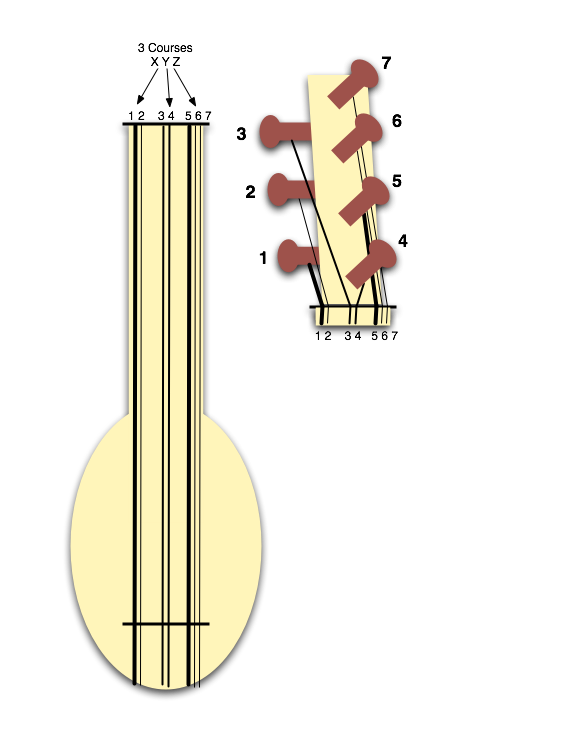This page explores how we should number or list the strings. But for the moment, we've had to go one way or the other. So see Standards and Conventions for how we do number and list the strings.
Abstract
There is a basic inconsistency between the commonly accepted conventions for numbering and listing the strings of stringed instruments. Suggestions are invited as to how to best resolve it.
String listing
If you hold a guitar up and look at it, the natural thing seems to be to hold it head up, and fingerboard before you. And if you then list the string tunings, the natural thing seems to be to list them E - A - D - G - B - E, and most people do, not just for guitars but for all stringed instruments. Fiddlers call G - D - A - D tuning geedad, and understand that this means the lowest string is G and the top D.
Or try it with our mascot the TB 36/12:

OK, it's a 12, so we'd list the courses rather than the strings, E - A - D - G - B - E. And everyone seems to do it that way. And they do it for guitar, and mandolin, and violin, and sitar, and saz, and every other instrument we've come across.
Well... not quite everyone. Many musicologists list them the other way around, but players and teachers generally list them as described above. Why on earth would musicology buck the trend? Ah, there is a reason.
String numbering
Almost everyone seems to agree that the first string of a guitar is the top E, and number them from then on (there's an exception in the external links section below, but they took some finding). This works well in many ways, for example extended instruments most often add bass strings, not treble strings, and instruments such as the sitar, saz and even the violin and electric guitar tend to do much or even most playing on the first string or strings, numbered in this way. Similar numbering is used on almost all stringed instruments, including guitar, and mandolin, and violin, and sitar (does that list sound familar?), by students, teachers, performers, and even musicologists (the one exception we've come across so far is the saz, see below).
And when listing string gauges, nearly all, perhaps all string makers list them from the first string down.
So this is what we end up with. A guitar in standard E-A-D-G-B-E tuning is like this:

Problem...
That means we list strings in the opposite order to the order in which we number them. It means that some musicologists, who tend to be a bit more logical about it than the rest of us (that's their job), write things that the rest of us find really confusing (they say it the other way around of course).
On the other hand, some Turkish saz players seem to number the strings from the bottom up:

It's a mess.
And just to make it even messier...
There are at least two other ways of numbering the strings. There's the Mauro Núñez system that numbers the strings from lowest to highest, and obviously you could also go from high to low. This numbering system is named after the Bolivian charango master Mauro Núñez, who uses it presumably.
These are certainly not solutions for this page! For an uncoursed instrument with a non-reentrant tuning, they're identical to the two numbering schemes already discussed. But for an instrument such as the charango with octave tuned courses they're interesting! For an instrument such as the ukulele, which has both reentrant and non-reentrant tunings, they would be disaster.
Solution?
Offer yours at this Yahoo! group. Please! Probably it's not fixable, but just in case it is, the sooner the better.
It's an open group, with an open membership and archive and currently anyone can post.
And maybe it just needs your insight to change the world for the better...
External links
Comments (0)
You don't have permission to comment on this page.